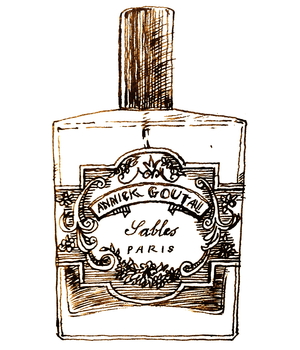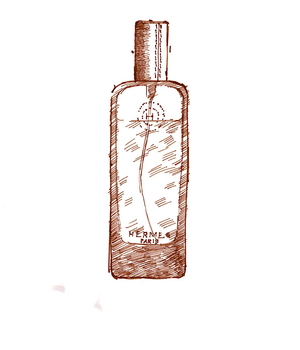Tagged With ‘sherry’
Annick Goutal
Sables
5 February, 2015
 Once you’ve smelled a lot of perfumes you start to realise when a scent is cheap and nasty – even on the occasions when it’s got a huge advertising budget and everyone seems to be buying it. (Why? Well, a lot of people still get swept up by advertising, but you can be fairly sure they’ll only buy it once.)
Once you’ve smelled a lot of perfumes you start to realise when a scent is cheap and nasty – even on the occasions when it’s got a huge advertising budget and everyone seems to be buying it. (Why? Well, a lot of people still get swept up by advertising, but you can be fairly sure they’ll only buy it once.)
But even among the most brilliantly put-together perfumes each person’s individual reaction counts for a lot. Smell taps in to such deeply rooted – and often subconscious – memories and associations for each of us that two people can have completely different gut-reactions to the same scent.
And not only that: it actually smells completely different to each of them, even though their brain is presumably processing the same elements in a fairly similar way. Most scientists seem to agree that, unless we suffer from particularly severe sight problems, the way I see Hèrmes orange is almost certainly the same as the way you see it.
Smell, though, appears to work in a rather different manner. We may well smell the same scents in the same objective way, but the personal associations that specific scents have for us seem to be more powerful than what we actually smell – conceivably for the simple reason that we have such trouble describing them in words.
Here’s a perfect example. Sables was first launched by the late, great French perfumer Annick Goutal in 1985, and though it was withdrawn from the UK market some time ago in one of those mysterious overnight disappearances that give the perfume industry its faint whiff of Stalinism, it can still be bought online and abroad.
Sables is one of my all-time favourite fragrances. Though its name is meant to evoke the high-summer sexiness of sun-baked sand, this fantastically rich, sweetly luxurious scent smells, to me, of all the best things about Christmas – vintage oloroso sherry, mince pies, the delicious heat of an applewood log fire, flaming brandy, Christmas pudding… All very positive associations, as far as I’m concerned.
I’d be the first to admit that Sables is strong stuff, best suited to opulent winter evenings; apply it too liberally and, like Guerlain’s L’heure bleue or Chanel’s No22, it can easily become overpowering. But while I can imagine choking on No22 in too high a concentration, to be overcome by Sables would, for me at least, be like drowning in a butt of Malmsey – frankly not a bad way to go.
To a friend who knows at least as much about perfume as I do, though, Sables has an unattractively medicinal smell with none of the enchanting connotations that give it such a deep and lasting appeal for me. I can (kind of) see what he’s getting at, and if I try hard I can just about identify a hint of cough-mixture about it, but for some reason that association, in my mind, is completely drowned out by all the good stuff I’ve already mentioned.
The moral? I’m not sure there is one, but I guess it’s always good to remember there’s no guarantee that everyone is going to share your passion for a particular perfume, no matter how wonderful it smells to you.
Hermès
Vétiver Tonka
18 August, 2014
 Like several other major perfume and fashion brands, Hermès has, in recent years, organised its range of perfumes into a number of different groups. I’m guessing that this is partly to help them refine their message for different segments of the market, but I also wonder whether it has something to do with their in-house perfumer, Jean-Claude Ellena, trying to bring order to a rather disparate collection of scents, in the way that a newly appointed curator might attempt to impose order on a rather muddled art collection.
Like several other major perfume and fashion brands, Hermès has, in recent years, organised its range of perfumes into a number of different groups. I’m guessing that this is partly to help them refine their message for different segments of the market, but I also wonder whether it has something to do with their in-house perfumer, Jean-Claude Ellena, trying to bring order to a rather disparate collection of scents, in the way that a newly appointed curator might attempt to impose order on a rather muddled art collection.
Whether intentionally or not, the groups have been divided in a way that reflects the gradual shift away from gendered to genderless scents, with most of the pre-Ellena perfumes being assigned, in the old-fashioned way, to either women or men (men getting Bel Ami, Equipage and Terre d’Hermès). By contrast most of the more recent scents are categorised by type, not gender, and described as ‘for sharing’ – currently five in Les Colognes collection, four in Les Jardins and eleven in the much more expensive Hermessences range, leaving Eau d’Hermès and Voyage d’Hermès standing on their own.
I’m guessing that the mass-market scents – Voyage and Terre d’Hermès – bring in most of the cash, but what seems to interest Hermès most (and, by extension, Jean-Claude Ellena) are the Hermessences: there are already more of them than there are in any other range, and they’re the only fragrances for which the company does its own in-house PR. They’re also almost twice the price of other Hermès scents: £161 for a 100ml eau-de-toilette as opposed to £73-£80 for a 100ml eau-de-toilette from any of the other groups.
Given how much they cost, you’d expect the Hermessences to be more unusual and have more staying-power than Hermès’ other perfumes, and at least in the case of Vétiver Tonka, that seems to be true. One often-repeated criticism of Jean-Claude Ellena is that the perfumes he creates tend towards the light and evanescent – delicate compositions that disappear all too quickly on the skin. Some people might regard that as a good thing, but as a value-for-money Yorkshireman I want to get some bang for my buck.
Vétiver Tonka certainly lasts, so that’s a good start. It’s also unusual, which for me is another plus – so many perfumes smell almost identical these days. But unusual doesn’t always mean attractive, or even wearable – just smell the amazing Bulgari Black, which is a brilliant scent, but also almost unwearable, at least outside a nightclub. Vétiver Tonka certainly isn’t in that league, but nor does it fit into an easily recognisable ‘normal’ category of scents.
Vetiver, of course, is a classic ingredient of many perfumes aimed at men: extracted from the roots of a tropical grass, it smells earthy and dry, but also fresh; it has the added advantage of being extremely long-lasting, and it can enhance the longevity of other ingredients too. The vetiver that Jean-Claude Ellena has used here, though, is a smoother, less rough-edged extract, which makes the perfume smell perhaps a little more feminine than I’d normally expect.
Tonka – the perfume ingredient, not the toy company – comes from the beans of the cumaru tree, Dipteryx odorata, which grows in Central America and, like laburnum and wisteria, belongs in the pea family. These beans yield coumarin, a chemical that was often used as a cheaper substitute for vanilla; coumarin also smells a bit like cinnamon, almonds or cloves, all of which I get traces of in Vétiver Tonka.
In many ways this is a perfume that does what it says on the tin, for if you can imagine the earthy smell of vetiver mixed with the foody smell of tonka (which many people find slightly chocolatey, probably because of its association with chocolate), then that’s pretty much how Vétiver Tonka smells. The vetiver helps it last all day, but what I mostly smell is the tonka, doubtless blended with many other things – there’s a gentle nuttiness, a bit like rum or sherry, or even a kitchen in the middle of baking day.
When I asked my mum what she thought of it she said, ‘It’s a very nice smell, but it doesn’t really smell like a perfume,’ and I think that pretty much sums it up. Not something you’d necessarily want to adopt as a signature scent, but a quality perfume to try if you fancy smelling a bit out of the ordinary. It also comes in a very nice Hermès box (with a rather cheap-looking cloth bag inside), and the clear-glass bottle – cleverly suffused with pale green – is satisfyingly chunky, with a stitched-leather cap, though whether all that makes it £161 I’m still not sure.